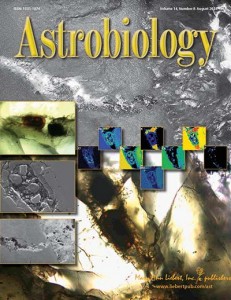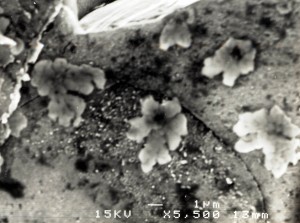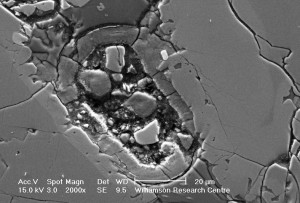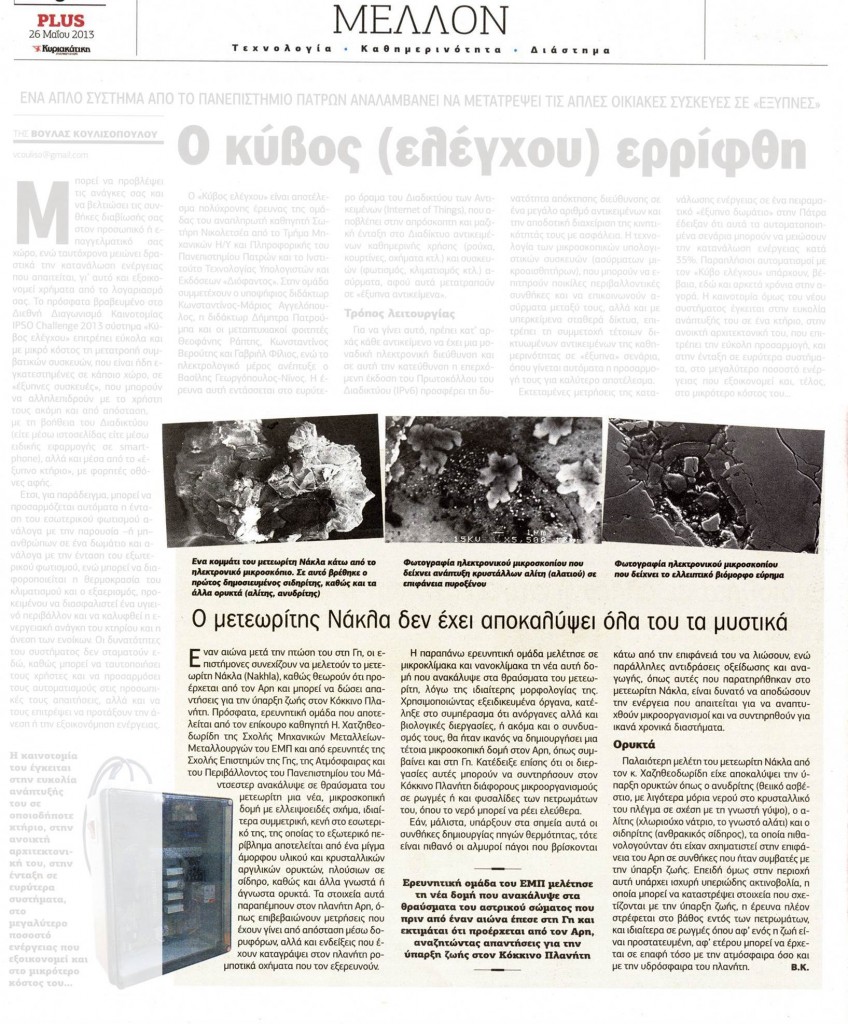New feature Article:
A Conspicuous Clay Ovoid in Nakhla: Evidence for Subsurface Hydrothermal Alteration on Mars with Implications for Astrobiology,
Elias Chatzitheodoridis, Sarah Haigh, Ian Lyon
Astrobiology. August 2014, 14(8): 651-693.
Open access article:
download full paper from here (PDF) or,
from here (Research Gate)
See the abstract here
and the press release from
the journal!
Finally, for many months, we were 2nd in the most read articles of
all articles of the last 12 issues of Astrobiology!
In 2014 calendar year only (since August) the paper reached more than 5,500 downloads.
Press release:
Cosmochemists team up with NanoScientist to investigate a cell-like structure from Mars.
While investigating the Martian meteorite, Nakhla, Dr Elias Chatzitheodoridis of the National Technical University of Athens discovered an unusual ‘cell-like’ feature embedded deep within the rock. In order to investigate the composition of this interesting structure and better understand what it might be, he teamed up with long time friend and collaborator Prof Ian Lyon at the University of Manchester. Intriguingly, their work showed that the feature in many ways resembled a fossilized cell from Earth but was undoubtedly from Mars. Both Lyon and Chatzitheodoridis wanted to delve deeper into the structure and composition of this structure and so brought it to Dr Sarah Haigh, a lecturer at the University of Manchester whose work usually involves high resolution imaging of nanomaterials for next generation electronic devices. She was able to image the structure at the nanoscale– revealing with unprecedented detail the local atomic layers of this feature inside the meteorite. Together their combined experimental approach has revealed new insights into the geological origins of this fascinating structure.
The investigators conclude that geology was likely the process that produced something that looked like a biological cell but that impacts on Mars generated hydrothermal fluid circulation with various chemical reactions that could support life, that water was present even recently in the sub-surface of Mars and that all the conditions for life are present in the deeper crust of Mars. Details of the work are published as the August 2014 cover article for the journal Astrobiology.
Κοσμοχημικοί συνεργάστηκαν με νανοεπιστήμονα για να διερευνήσουν μια δομή από τον Άρη που μοιάζει με απολιθωμένο μικροοργανισμό.
Κατά την διερεύνηση του μετεωρίτη Nakhla από τον πλανήτη Άρη, ο Δρ Ηλίας Χατζηθεοδωρίδης του Εθνικού Μετσόβιου Πολυτεχνείου ανακάλυψε μια ασυνήθιστη δομή ενσωματωμένη βαθιά μέσα στο πέτρωμα του μετεωρίτη. Προκειμένου να διερευνηθεί η σύνθεση αυτής της ενδιαφέρουσας δομής με λεπτομέρεια και να γίνει καλύτερα κατανοητό το τι θα μπορούσε να είναι, συνεργάστηκε με τον από χρόνια φίλο και συνεργάτη καθηγητή Ian Lyon από το Πανεπιστήμιο του Μάντσεστερ. Περιέργως, η έρευνά τους έδειξε ότι η δομή αυτή έμοιαζε πολύ με τους απολιθωμένους μικροοργανισμούς που βρίσκουμε στη Γη, ωστόσο η προέλευσή του ήταν αναμφισβήτητα από τον πλανήτη Άρη. Οι δύο ερευνητές ήθελαν να εμβαθύνουν ακόμη περισσότερο στη μελέτη της δομής και της σύνθεσης αυτής, και έτσι επικοινώνησαν με την Dr Sarah Haigh, λέκτορα στο Πανεπιστήμιο του Μάντσεστερ, της οποίας τα ερευνητικά ενδιαφέροντα περιλαμβάνουν κυρίως υψηλής ανάλυσης απεικονίσεις νανοϋλικών που χρησιμοποιούνται για τις ηλεκτρονικές συσκευές της επόμενης γενιάς. Κατά την μελέτη της δομής σε νανοκλίμακα αποκάλυψαν με πρωτοφανή λεπτομέρεια τα δομικά χαρακτηριστικά αυτής, που είχαν την μορφή νανοστρωματιδίων. Ο συνδυασμός των πειραματικών τους προσεγγίσεων αποκάλυψε νέες γνώσεις σχετικά με τη γεωλογική προέλευση αυτής της συναρπαστικής δομή.
Οι ερευνητές καταλήγουν στο συμπέρασμα ότι πιθανότατα γεωλογικές διεργασίες παρήγαγαν τη δομή αυτή που μοιάζει με ένα βιολογικό κύτταρο, και είναι αποτέλεσμα της κυκλοφορίας υδροθερμικών ρευστών που κινητοποιήθηκαν μετά από την πτώση άλλων μετεωριτών στην επιφάνεια του πλανήτη. Ωστόσο, οι πολύπλοκες χημικές αντιδράσεις που συμβαίνουν στο εσωτερικό της επιφάνειας του πλανήτη θα μπορούσαν να υποστηρίξουν τη ζωή στον πλανήτη, καθώς επίσης ότι το νερό υπήρχε ακόμη και πρόσφατα κάτω από την επιφάνεια του Άρη, ενώ πληρούνται όλες οι προϋποθέσεις ώστε η ζωή να είναι παρούσα στο βαθύτερο φλοιό του πλανήτη. Οι λεπτομέρειες της εργασίας δημοσιεύθηκαν στο τεύχος του Αυγούστου του επιστημονικού περιοδικού Astrobiology
Media
Παρουσία σε Ελληνικά Μέσα Μαζικής Ενημέρωσης
- Το ΒΗΜΑ (1ο σύντομο άρθρο & 2ο Εκτενές Άρθρο)
- ΕΝΙΚΟΣ (enikos.gr) – Από άρθρο στον ΕΛΕΥΘΕΡΟ ΤΥΠΟ (έντυπη έκδοση)
- Δημοκρατία
- ΝΑΥΤΕΜΠΟΡΙΚΗ
- www.astronomy-astrophotography.gr
- ΕΞΕΛΙΞΗ online
- OpinionPost.gr
- Palo
- Enet.gr ΕΛΕΥΘΕΡΟΤΥΠΙΑ
- ΣΚΑΪ – ΤΩΡΑ με την Άννα Μπουσδούκου (στο 01:35:00 λεπτά)
Παρουσία σε ξένα μέσα:
- NASA’s ASTROBIOLOGY MAGAZINE (ASTROBIO.NET)
- SPACE.COM
- SCI-NEWS.COM
- SCIENCE20.COM
- SCIENCEDAILY.COM
- IFLSCIENCE.COM
- DISCOVERY.COM
- LIFE-ORIGINS.COM
- MANCHESTER UNIVERSITY
- PHYS.ORG
- REDPLANET.ASU.EDU
- BUSINESSINSIDER.IN
- TECHTREND24.COM
- TECHTIMES.COM
- FRENCHTRIBUNE.COM
And many others in different languages (different countries!)
And someone did a YOUTUBE video for that !!!!!
https://www.youtube.com/watch?v=ejsQgf1h6Tw
Past work on Nakhla
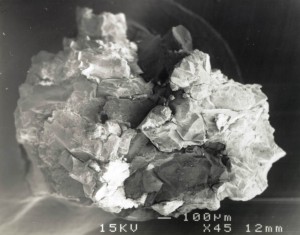 An untreated chip of the Nakhla meteorite.
An untreated chip of the Nakhla meteorite.
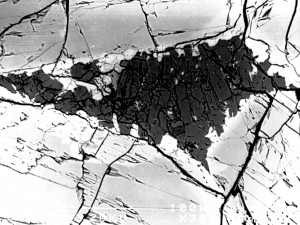 The first siderite (carbonate) that was discovered in Nakhla.
The first siderite (carbonate) that was discovered in Nakhla.
Halite crystals in Nakhla (the sample chip above; no chemical or any treatment)
New discoveries
A conspicuous clay ovoid in Nakhla (SEM BSE image).
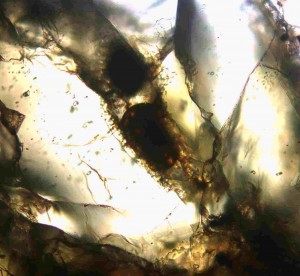
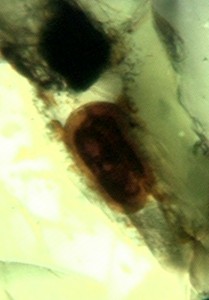
The clay ovoid under the transmitted light optical microscope.
